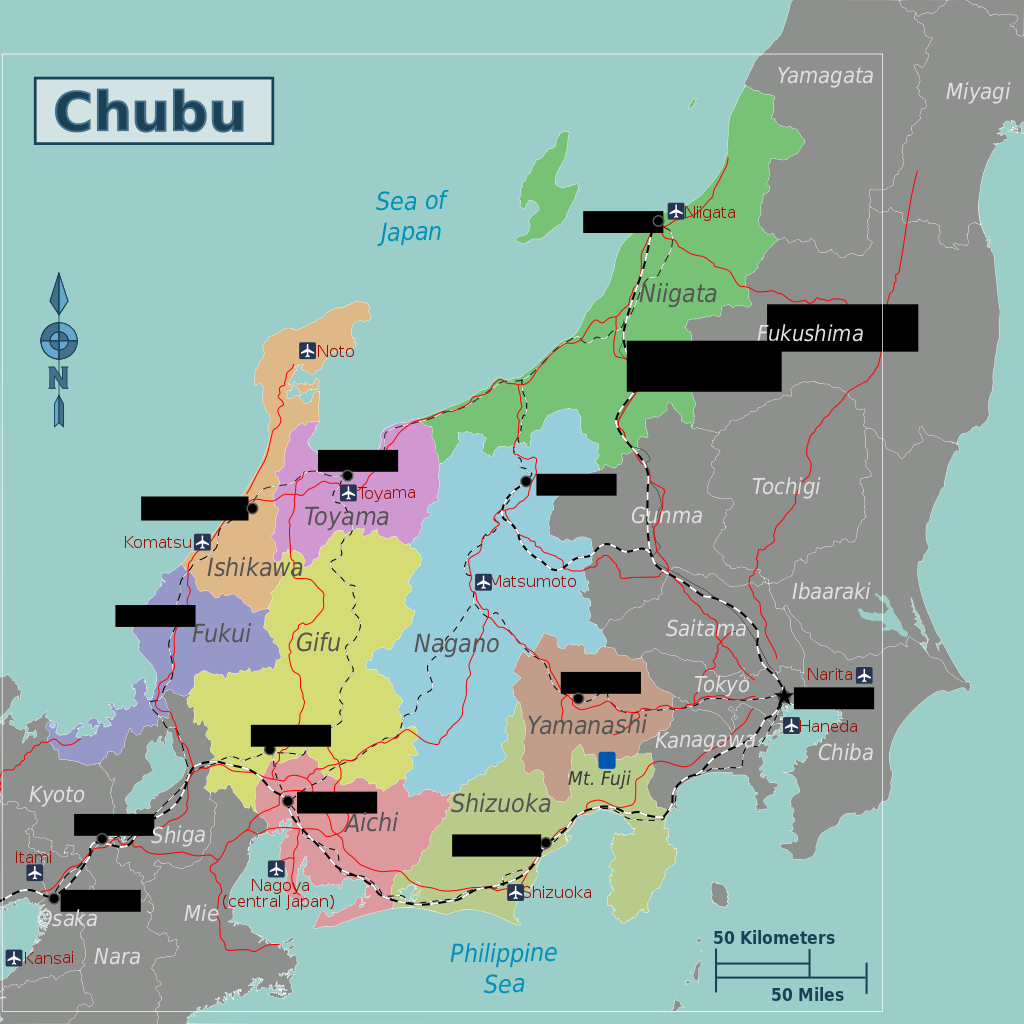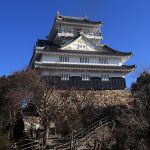 Nestled in the heart of Japan, the Chubu region, conveniently located between the bustling cities of Osaka and Tokyo, is a tapestry of cultural, natural, and technological marvels. This region, characterized by its stunning natural beauty, is home to the iconic Mount Fuji and the majestic Japanese Alps. These natural wonders provide a picturesque backdrop for many outdoor activities, ranging from serene hikes to exhilarating skiing adventures.
Nestled in the heart of Japan, the Chubu region, conveniently located between the bustling cities of Osaka and Tokyo, is a tapestry of cultural, natural, and technological marvels. This region, characterized by its stunning natural beauty, is home to the iconic Mount Fuji and the majestic Japanese Alps. These natural wonders provide a picturesque backdrop for many outdoor activities, ranging from serene hikes to exhilarating skiing adventures.
Chubu is also a treasure trove of cultural heritage, boasting historic towns like Takayama and Kanazawa. These towns are time capsules of Japan’s rich history, with Kanazawa offering a glimpse into the Edo era through its well-preserved districts and art museums. The region’s diverse climate, from mild coastal areas to cooler mountainous zones, makes it a year-round destination, each season offering its unique charm.
The hot spring towns, or onsen, such as Hakone and Gero, are quintessential experiences in Chubu, offering relaxation and rejuvenation amidst scenic settings. Gastronomically, the region is a haven for food enthusiasts, offering delicacies ranging from fresh seafood to exquisite local sake, not to mention regional specialties like Hida beef.
Chubu’s reputation extends to its craftsmanship in pottery, textiles, and woodwork, with places like Takayama showcasing the skill and tradition of Japanese artisans. Furthermore, the region is a hub of industry and technology, with Nagoya leading in the automobile and aerospace sectors.
The Chubu region, the heart of Japan, is a harmonious blend of nature’s splendor, cultural depth, and modern innovation. It’s a destination that promises a rich tapestry of experiences to every visitor, encapsulating the essence of Japan in its most authentic form.
Aichi Prefecture
With Nagoya as its capital, Aichi is a vibrant hub of commerce and culture. Known for the global headquarters of Toyota, the city also boasts historical landmarks like Nagoya Castle. Aichi is a bustling metropolis blending modernity with tradition.
- Major City: Nagoya (Population: ~2.3 million)
- Prefectural Population: ~7.5 million
- Tourist Highlights: Nagoya Castle, Toyota Commemorative Museum of Industry and Technology
- Economic Drivers: Automotive industry, aerospace, manufacturing
- Famous Foods: Hitsumabushi (grilled eel), Kishimen (flat udon noodles), Tenmusu (tempura rice balls)
Gifu Prefecture
Just a stone’s throw from Nagoya, Gifu offers a journey into Japan’s historical heartland. Visit the UNESCO World Heritage sites of Shirakawa-go and Gokayama or explore the traditional cormorant fishing on the Nagara River. Gifu City, the capital, provides a peaceful contrast to the hustle of Nagoya.
- Major City: Gifu (Population: ~400,000)
- Prefectural Population: ~2 million
- Tourist Highlights: Historic villages of Shirakawa-go and Gokayama, Cormorant fishing on Nagara River
- Economic Drivers: Traditional industries, modern manufacturing, tourism
- Famous Foods: Hoba Miso (miso grilled on magnolia leaf), Keichan (chicken marinated in miso and soy sauce)
Ishikawa Prefecture
The jewel of Ishikawa is Kanazawa, a city where samurai, geisha, and artisans flourished. Today, it’s a treasure trove of art, culture, and cuisine. It’s a place where the past and present seamlessly converge.
- Major City: Kanazawa (Population: ~460,000)
- Prefectural Population: ~1.1 million
- Tourist Highlights: Kenrokuen Garden, Kanazawa Castle, Higashi Chaya District
- Economic Drivers: Tourism, crafts (like Kaga Yuzen silk), fishing
- Famous Foods: Kaga cuisine, Seafood (especially crab), Kanazawa curry
Toyama Prefecture
Toyama is a paradise for nature enthusiasts, known for its breathtaking natural landscapes, including the Tateyama Kurobe Alpine Route. The city of Toyama offers a serene urban environment surrounded by the splendor of the Japan Alps.
- Major City: Toyama (Population: ~420,000)
- Prefectural Population: ~1 million
- Tourist Highlights: Tateyama Kurobe Alpine Route, Kurobe Gorge
- Economic Drivers: Pharmaceutical industry, electronics, manufacturing
- Famous Foods: Masu Sushi (trout sushi), Hotaru Ika (firefly squid)
Fukui Prefecture
Home to one of Asia’s most significant dinosaur museums and the serene Eiheiji Zen Temple, Fukui is a blend of educational exploration and spiritual discovery.
- Major City: Fukui (Population: ~260,000)
- Prefectural Population: ~780,000
- Tourist Highlights: Fukui Prefectural Dinosaur Museum, Eiheiji Temple
- Economic Drivers: Nuclear energy, textiles, machinery
- Famous Foods: Echizen crab, Soba noodles
Yamanashi Prefecture
Offering stunning views of Mount Fuji and the idyllic Five Lakes region, Yamanashi is perfect for outdoor adventurers and those seeking scenic beauty.
- Major City: Kofu (Population: ~190,000)
- Prefectural Population: ~830,000
- Tourist Highlights: Mount Fuji, Fuji Five Lakes
- Economic Drivers: Wine production, jewelry, precision machinery
- Famous Foods: Houtou (noodle stew), Yamanashi wine
Nagano Prefecture
Famous for hosting the 1998 Winter Olympics, Nagano is a haven for winter sports enthusiasts. Its hot springs and the historic Zenko-ji Temple offer relaxation and cultural exploration.
- Major City: Nagano (Population: ~370,000)
- Prefectural Population: ~2.1 million
- Tourist Highlights: Zenko-ji Temple, Japan Alps, ski resorts
- Economic Drivers: Precision machinery, electronics, agriculture
- Famous Foods: Shinshu Soba (buckwheat noodles), Nozawana pickles
Niigata Prefecture
Renowned for its premium rice and sake, Niigata boasts beautiful coastal landscapes and enriching cultural festivals on Sado Island.
- Major City: Niigata (Population: ~800,000)
- Prefectural Population: ~2.3 million
- Tourist Highlights: Sado Island, Niigata rice fields, ski resorts
- Economic Drivers: Agriculture (especially rice and sake production), heavy machinery
- Famous Foods: Koshihikari rice, Sasa dango (rice dumplings wrapped in bamboo leaves)
Shizuoka Prefecture
Shizuoka is famous for its green tea and offers a view of Mount Fuji like no other. The Izu Peninsula, with its hot springs and coastal beauty, is a must-visit for relaxation and natural exploration.
- Major City: Shizuoka (Population: ~700,000)
- Prefectural Population: ~3.7 million
- Tourist Highlights: Mount Fuji, Izu Peninsula, Shizuoka Sengen Shrine
- Economic Drivers: Tea production, automotive, fishing
- Famous Foods: Green tea, Sakura shrimp, Unagi (eel)
Kambayashi, CC BY-SA 3.0, via Wikimedia Commons
TUBS, CC BY-SA 3.0, via Wikimedia Commons




